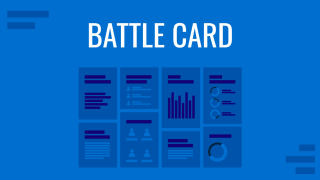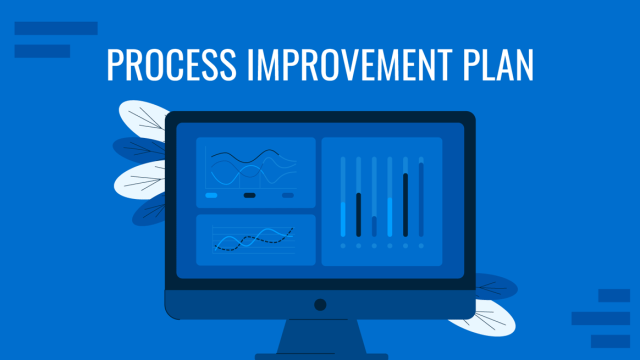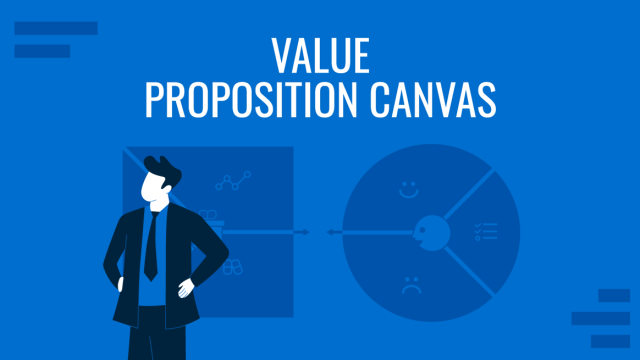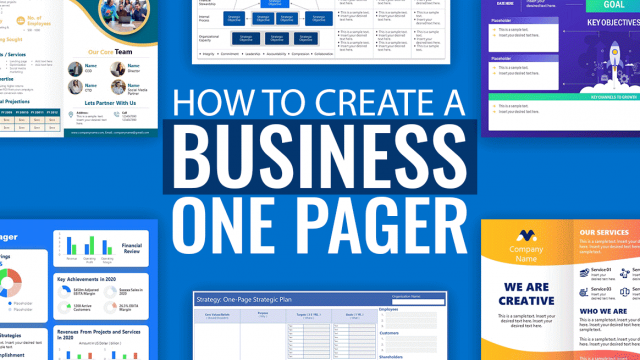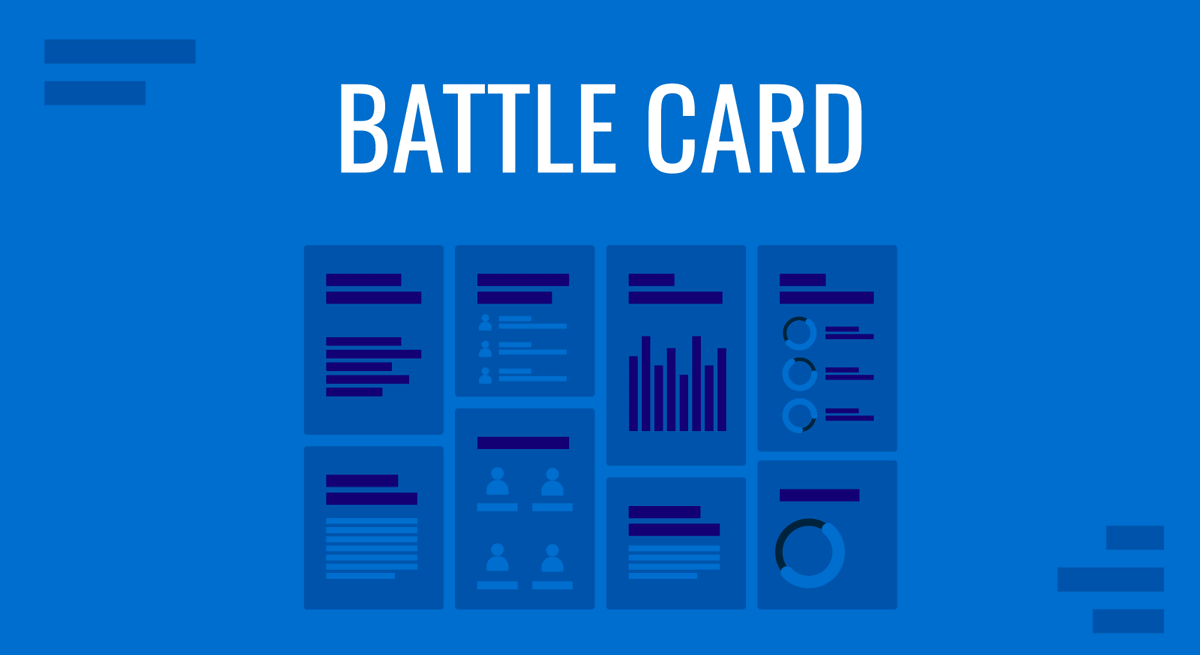
Sometimes, sales conversations go smoothly; they usually go on a rough sail – pun intended. Your sales team can encounter many challenges, especially when dealing with objections or competing against rival solutions. While this is nothing new to you, what you truly seek is how to overcome these hurdles and steer toward success.
To succeed in the competitive sales landscape, your team needs a robust system of sales enablement tools that allows them to forge deep connections with potential clients. And one tool stands out among the rest—the battle card.
What Is a Sales Battle Card?
Jargonism defines a sales battle card, also called kill sheets or competitive cards, as a short document that provides a company’s sales team with key information and talking points about their product or service, typically including insights on how to win against competitors.
However, sales battle cards serve as a valuable resource beyond competitive analysis. They also contain details about products or services, objections commonly encountered in the sales process, and persuasive responses to counter those objections.
Sales teams and their managers primarily utilize battle cards. Sales representatives rely on battle cards as a quick reference during a sales pitch or call made via business phone system to ensure they have accurate and compelling information at their fingertips.
Sales managers and enablement teams are critical in creating and updating battle cards. They conduct research on competitors, gather market insights, collaborate with product teams, and consult subject matter experts to develop comprehensive battle cards that align with the sales strategy and goals of the organization.
What Should Be Included in Battle Cards?
A well-crafted battle card can be a game-changer in the competitive sales landscape. To help you create impactful battle cards, we’ve prepared an editable template, incorporating key elements to equip your sales team with the necessary tools for success.
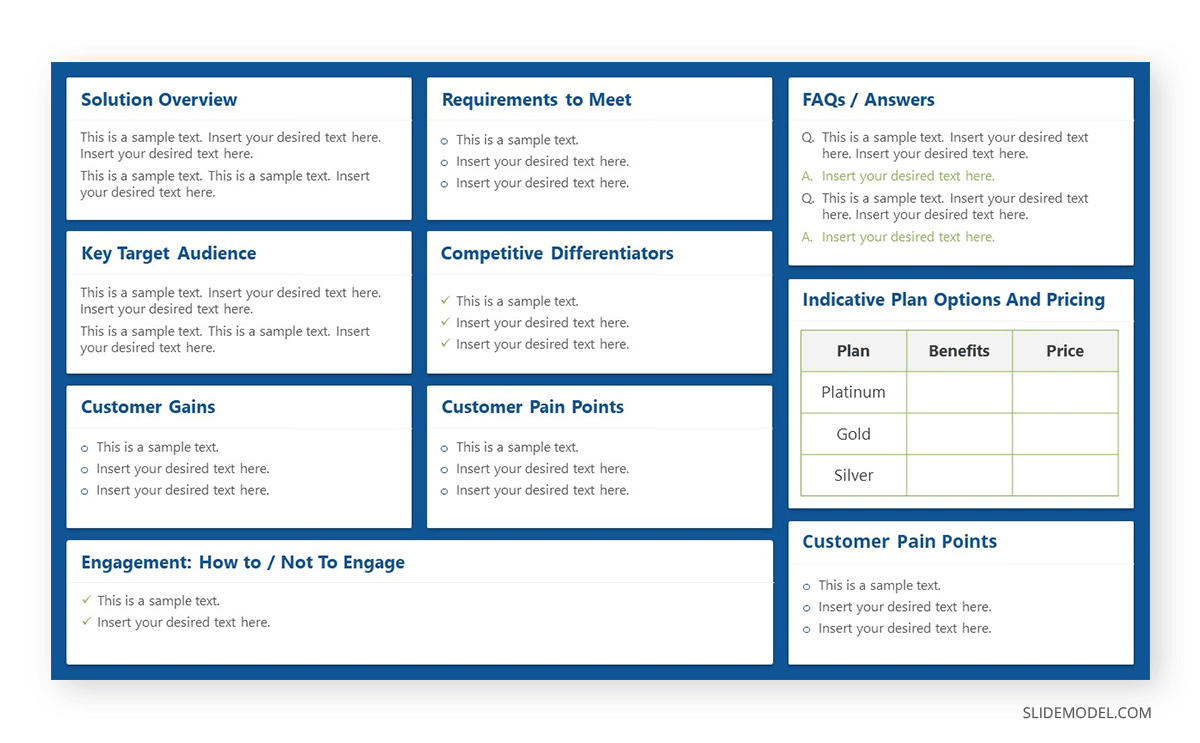
- Product overview
- Target audience or the specific customer segment that the battle card applies to.
- Requirements to meet
- Customer pain points
- Customer gains
- Competitive differentiators
- Pricing and Features
- FAQs
- Engagement strategies
Benefits of Battle Cards in Sales Pitch
1. Organized and Focused Presentation
Sales representatives could fall into two traps when there’s a lack of structured and organized approach to sales conversations: (1.) they talk too much, making the buyer smell desperation a mile away, or (2.) they talk too little, making it seem they don’t understand their business.
Armed with battle cards, your sales reps can confidently present just the right amount of information, emphasizing the most crucial aspects of their product or service. This approach helps build trust, demonstrate expertise, and effectively position the product or service as a valuable solution for the buyer’s needs.
2. Overcoming Objections
Objections are an inevitable part of the sales journey. However, battle cards equip sales teams with the knowledge and strategies to address objections head-on. These valuable resources provide ready-made responses, persuasive arguments, and effective counterpoints, enabling sales professionals to navigate objections with finesse, build trust, and ultimately win over skeptical prospects.
3. Outshine Competitors
As mentioned earlier, competitors are a primary component of sale battle cards. By carefully examining your competitors’ merit and demerit points, you gain a comprehensive understanding of their offerings, market positioning, and unique value propositions. Armed with this knowledge, your sales professionals can effectively differentiate your offering, showcasing its superior benefits and advantages compared to the competition.
4. More Successful Deal
As a result of the above benefits, battle cards are crucial in converting leads into satisfied customers. They provide sales professionals with the tools to navigate the sales journey confidently, engage customers effectively, and guide them toward a positive purchasing decision. The result? More closed deals, increased revenue, and a profound sense of achievement.
How to Create a Sales Battle Card
1. Define Who’s the Audience
To start, you must identify your battle cards’ target audience. Are the leads coming from inbound channels or outbound? What’s the level of awareness of your target customers? This information will guide you in creating buying personas that allow a more personalized approach to crafting battle cards that precisely address your customers’ information needs.
As Stefan Koenig from Hull Inc. rightly points out, inbound leads come with a known problem, whereas outbound leads require selling the value of your solution.
For battle cards targeting inbound leads, focus on providing detailed information about how your solution addresses their known problem. Craft battle cards that highlight specific features, functionalities, and benefits of your product or service.
Conversations with outbound leads require a different approach. These leads may not be fully aware of their problems or solutions. Battle cards aimed at outbound leads should focus on the selling value and benefits of your offering. They should aim to educate and create a compelling case for your success.
2. Know Your Competitors
Similar to how a competitor slide can greatly impact your sales presentation, integrating competitive insights into your battle cards is important. They equip your sales team with the knowledge and strategies needed to outshine competitors and achieve sales success. And they can be a great component to include in your sales presentations or to use in a sales enablement plan presentation template.
Take note of the competitors that often arise during sales calls. Conduct comprehensive research on these competitors, examining their offerings, market presence, pricing, strengths, and weaknesses.
You may develop a multi-competitor analysis template that sales reps can pull out during a pitch. This template should include key information about each competitor, such as product features, pricing, customer testimonials, and differentiating factors.
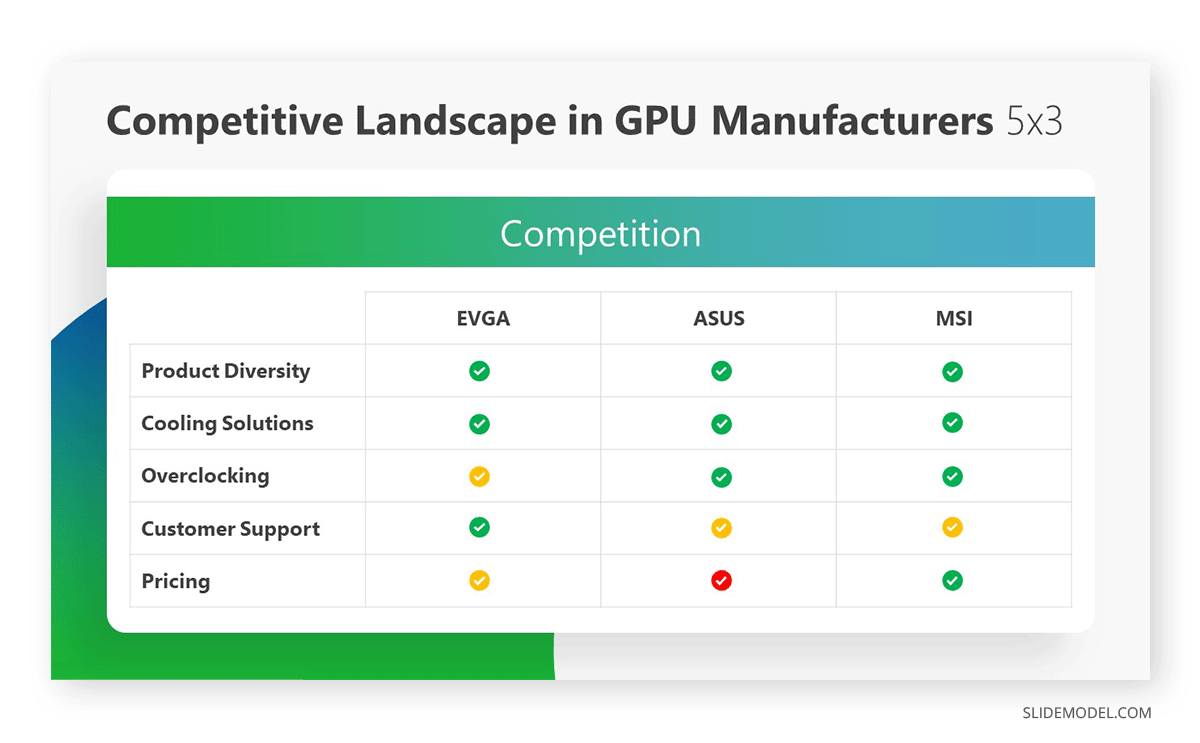
3. Position Your Products
Once you have deeply understood your competitors, it’s time to position your products or services strategically. This crucial step is the foundation for crafting persuasive battle cards that resonate with your target audience.
To effectively position your offerings, it’s essential to clearly define your unique value proposition and identify the key benefits and features that set you apart from the competition. Consider the following questions to guide your process:
- What Makes You Stand Out?
- How does your offering alleviate customer pain points?
Surveys are a helpful tool to gather valuable insights and validate your positioning with your existing customers. Include open-ended questions to encourage them to provide detailed feedback about their experiences with your products and services and what they perceive as your strengths and weaknesses.
4. Craft Your Battle Card Template
It’s time to put everything together and craft impactful battle cards. Start by organizing the gathered information, ensuring it is easily accessible to your sales team.
Create a structured format that allows for clear and concise messaging. Consider using sections or categories to organize the content, such as product overview, competitive analysis, value proposition, features, and engagement strategies.
You may also add supporting materials that complement your battle cards. They could include customer testimonials, success stories, and case studies that add credibility to your offering.
5. Train Your Sales Team to Use Battle Cards
Creating battle cards is the first step; training your sales team to use them effectively is crucial. As you’re onboarding new team members, or conducting refresher training for your existing team, ensure your sales representatives understand the content and messaging in the battle cards.
The training goal is to:
- Familiarize the sales team with the battle card template and its sections.
- Provide in-depth knowledge about competitors and their strengths and weaknesses.
- Share best practices for engaging with leads, addressing objections, and leveraging the battle cards during sales conversations.
6. Measure and Iterate
Once your battle cards are used, measuring their effectiveness and gathering feedback is essential. Monitor key metrics such as conversion rates, deal sizes, and customer feedback. This data will help you identify areas for improvement and fine-tune your battle cards for optimal results. Continually iterate and update your battle cards to align with evolving market dynamics and customer needs.
Sales Battle Cards in Action
Let’s put battle cards in action using T-Mobile as a case study.
In the case of T-Mobile, a telecommunications company, battle cards can be invaluable for their sales teams. The company operates in a highly competitive industry. By utilizing battle cards, T-Mobile’s sales teams can have a comprehensive understanding of the competition and be better equipped to highlight T-Mobile’s advantages over other carriers.
Here’s what its battle card for selling its most expensive unlimited data plan, the Go5G Plus, might look like.
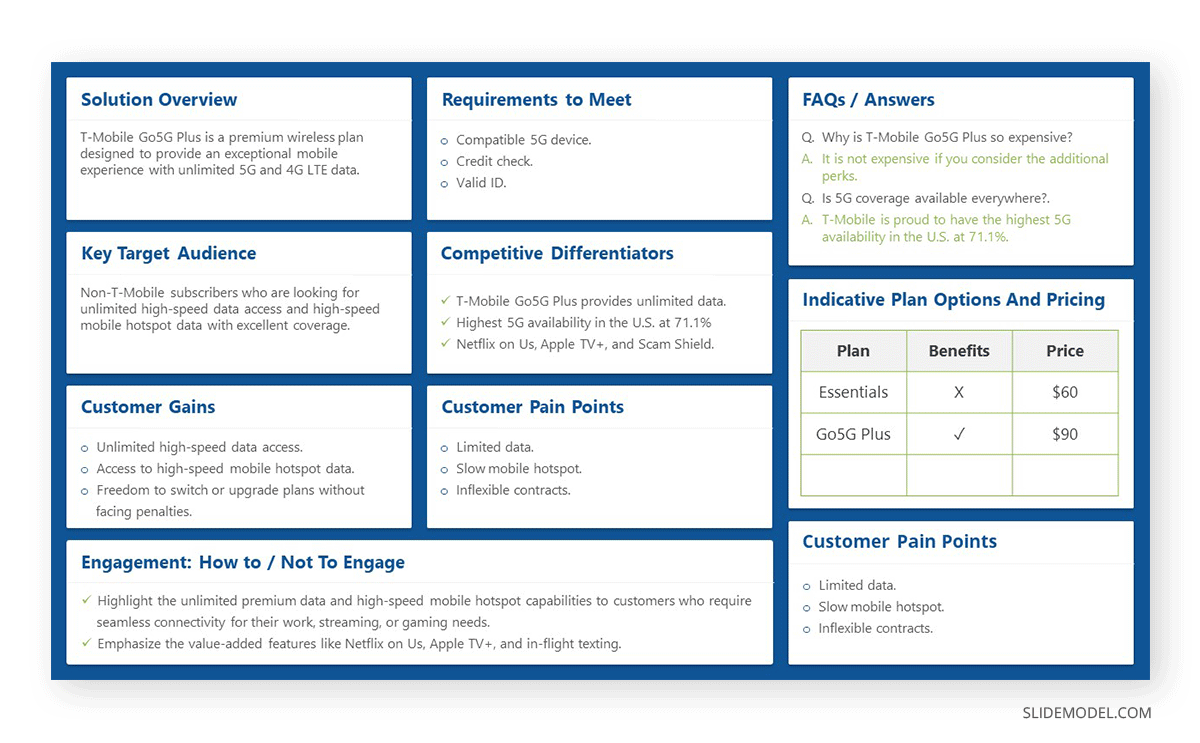
Product Overview:
T-Mobile Go5G Plus is a premium wireless plan designed to provide an exceptional mobile experience with unlimited 5G and 4G LTE data, a high-speed mobile hotspot, unlimited talk and text, and various additional features.
Target Audience:
Non-T-Mobile subscribers who are looking for unlimited high-speed data access and high-speed mobile hotspot data with excellent coverage
Requirements to Meet:
To qualify for T-Mobile Go5G Plus, customers must have a compatible 5G device, a credit check, and a valid ID.
Customer Pain Points:
- Limited data
- Slow mobile hotspot
- Inflexible contracts
Customer Gains:
- Unlimited high-speed data access
- Access to high-speed mobile hotspot data
- Freedom to switch or upgrade plans without facing penalties
Competitive Differentiators:
- T-Mobile Go5G Plus provides unlimited premium data, ensuring customers have high-speed internet access for all their online activities.
- T-Mobile records the highest 5G availability in the U.S. at 71.1%, compared to AT&T’s 68.7% and Verizon’s 37.6%.
- The plan includes various value-added features such as Netflix on Us, Apple TV+, and Scam Shield.
Pricing and Features Comparison
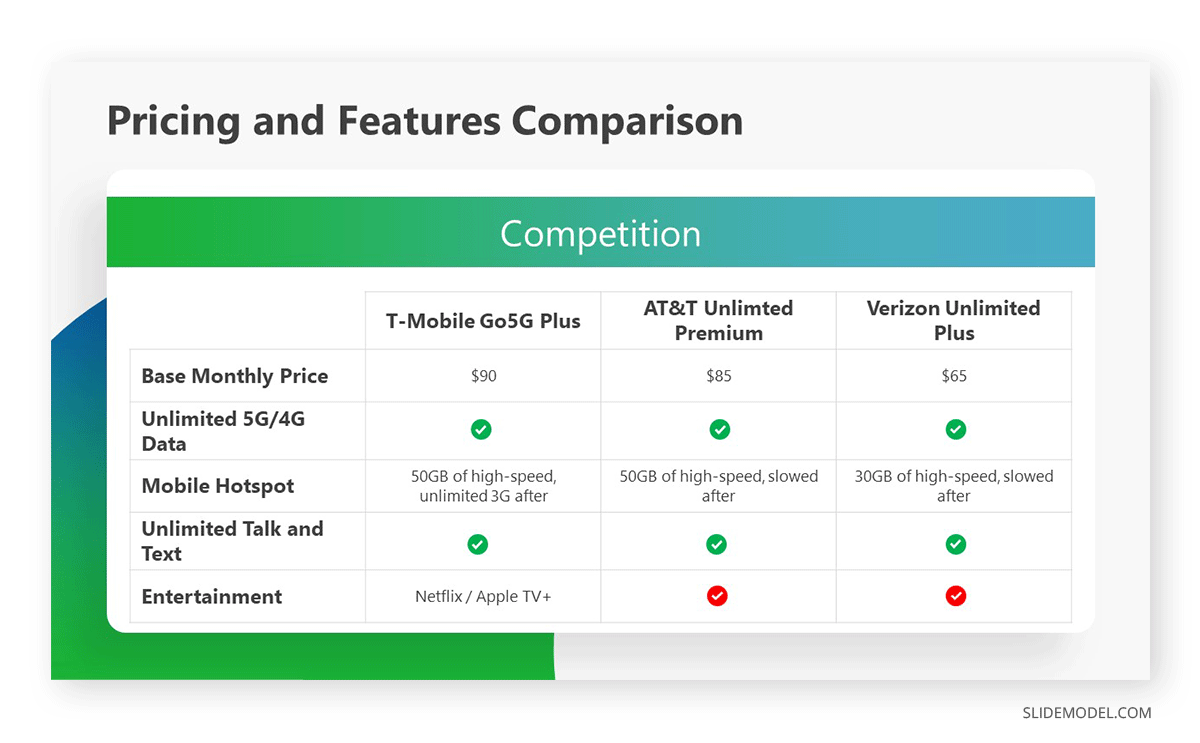
FAQs/ Objections:
- Why is T-Mobile Go5G Plus so expensive?
- T-Mobile Go5G Plus is not expensive when you consider the value it provides. It includes various value-added features, such as Netflix on Us and Apple TV+, not offered by competitors. Plus, you can save money by adding more lines to your plan or taking advantage of T-Mobile’s promotions and discounts.
- Is 5G coverage available everywhere?
- T-Mobile is proud to have the highest 5G availability in the U.S. at 71.1%, surpassing both AT&T’s 68.7% and Verizon’s 37.6%. We are continuously expanding our 5G network to ensure broader coverage, but it’s important to note that 5G availability may vary based on location. Check T-Mobile’s coverage map for more details.
- Can I get a similar plan with lower monthly pricing from AT&T or Verizon?
- Absolutely! We offer significant discounts for every line added to your plan. For example, with our current promotion, you can get two lines for just $75 each, and the best part is, when you add a third line, it’s completely free. This means you can enjoy the advantages of T-Mobile Go5G Plus at a more affordable price than AT&T’s $60 per line for their three-line plan.
Engagement Strategies:
- Highlight the unlimited premium data and high-speed mobile hotspot capabilities to customers who require seamless connectivity for their work, streaming, or gaming needs.
- Emphasize the value-added features like Netflix on Us, Apple TV+, and in-flight texting and Wi-Fi to showcase the additional perks of the plan.
- Address customer concerns about contract restrictions by emphasizing T-Mobile Go5G Plus’s contract-free nature and flexibility.
Disclaimer: The above example is for reference purposes only and does not constitute an endorsement or recommendation of any specific product, service, or company.
Conclusion
You can’t predict the direction and outcome of every sales conversation. However, by incorporating battle cards into your sales strategy, you can set yourself up for success through careful planning.
Battle cards provide a roadmap, equipping your sales team with the knowledge, insights, and strategies to navigate conversations confidently. With some planning and the right tools, you can seize opportunities, address objections, and ultimately drive more successful sales outcomes.
